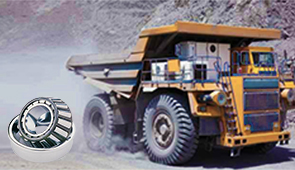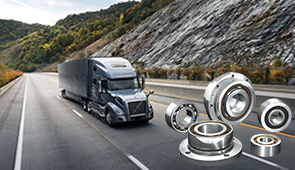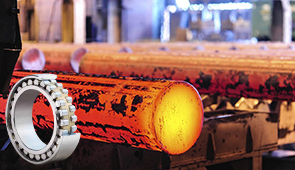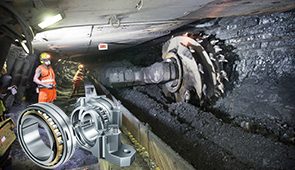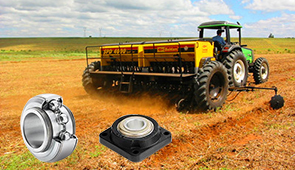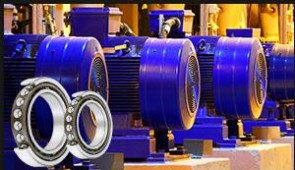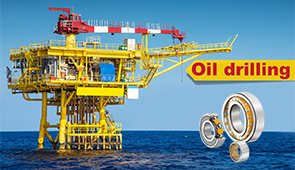Key Differences Between Grease and Oil for Bearing
When selecting the appropriate lubricant type for bearing lubrication, it is imperative to determine the machinery’s operating performance, efficiency, and life cycle. Bearings provide smooth and reliable motion, and whether to use grease or oil as a lubricant is determined by the application’s operating conditions, load conditions, and bearing maintenance. However, this article attempts to explain the difference between using grease and oil in bearing lubrication so that you can choose the more appropriate bearing. This knowledge enables you to see the benefits, disadvantages, and application of each lubricant and hence make appropriate choices so that the equipment performs well for a long time.
What are the key differences between grease and oil for bearing lubrication?
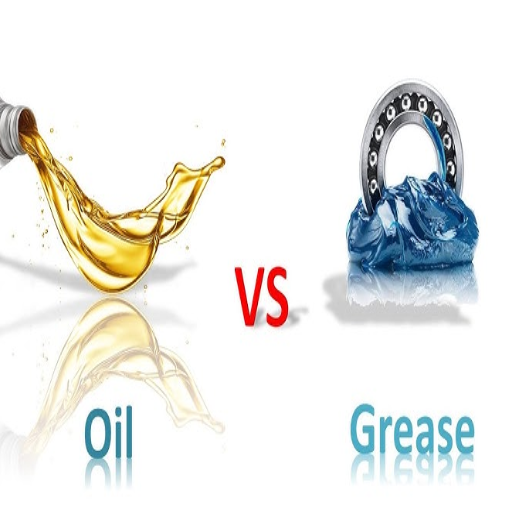
How do grease and oil differ in composition?
The difference between oil and grease lies significantly in their structure and, as a result, their way of performing bearing lubrication. Grease is a type of multi-purpose lubricant. Grease has a semi-solid texture, meaning it has a base oil, thickeners, and some additives. The two main ingredients that give grease its lubricating properties are mineral or synthetic oil, which is considered the base oil, and thickeners, such as lithium, calcium, or other complex soaps, which give it texture. Admixes are built into the oil to provide better results, such as anti-wear, salt, and thermal stability. On the other hand, Grease is ideal for use in areas and applications requiring long-term lubrication, sealing, and easy containment.
On the other hand, oil is a base oil, and its combined additives offer versatility in controlling major lubricant parameters. Oil is extraordinarily lightweight and fluid, making it suitable for highly performant areas where heat dissipation is critical. Viscosity is an important technical parameter to consider when using oil, this is the determining factor of the speed and temperature at which the bearing can withstand and continues to perform effectively without putting oil at the fringes of functionality. Furthermore, since oil can circulate and transfer heat, it is much easier to handle high operating temperatures.
Whether you want to use grease or oil depends on the overall speed, temperature, contamination, and, most importantly, the maintenance of the task or project at hand.
What are the main advantages of using grease over oil?
Over the advantages of oil, grease is favored in some applications where minimal input is required to maintain the lubricants. Some of them include:
Ease of Application: Grease does not migrate from its place. For example, it can be applied on bearings or gears, enabling a decrease in re-lubrication frequency. The area around the component stays lubricated even if it’s difficult to reach.
Improved Protection: Grease is not as easily contaminated because it is viscous enough to withstand dirt and dust, making it beneficial in open and dirty areas.
Less Upkeep: Applied grease can stick on the components quite well, thus making it possible for the application not to be applied again and again, unlike the case of oil.
Good Endurance: Most greases, for instance, lithium-complex grease, are made to help in elevated temperatures of 250 degrees, while synthetic greases help withstand temperatures of over 260 degrees.
Anti-Shock Load: Grease is thicker due to its density, which cushions the machine’s components, allowing them to withstand sudden shock loads and high vibrations.
Lower chance of leaks: Grease is more viscous than oil. Owing to this fact, it has a low chance of getting poured out, making it suitable for oscillating or experimental motion.
Increased durability: An application using grease can be made for an extended time without requiring maintenance, such as seal bearings.
Considering the factors mentioned and the more technical requirements, such as the temperature or environmental range and the load capacity, grease becomes the ultimate solution for many industrial sectors that need reliable and long-lasting lubrication solutions.
When is oil lubrication preferred over grease?
Oil is a viable option for lubrication over grease in scenarios where there are complicated but extremely delicate systems that require a high cooling effect, reduction of friction at high speeds, or an increase in lubrication owing to the inherent design of the machinery and the operating environment. Some of the critical cases where oil is best suited are:
High-Speed Applications: Oil can lubricate machines’ internal components and help dissipate the heat on high-speed machines such as compressors and turbines.
Continuous Lubrication Requirements: The oil is best, usually through circulation systems that clean and cool the oil in that constant lubrication occurs in gearboxes and hydraulic systems.
Enhanced Heat Transfer: Unlike some solid substances, oil is a fluid. This property makes heat easily transferred away from components, making it applicable even in extreme temperatures.
Space Limitations: Oil is pumped or put in reservoirs when the lubrication point is remote, in limited space, in low-pressure areas, or where lubrication must be automatically supplied.
Cleaning of Contaminated Zones: Oil is the perfect component for consistently removing particles such as metal peels and dust from some areas. It is pretty effective when used with an oil circulation system containing a filtration system.
Considering these factors, along with the technical parameters, assists in maintaining a particular standard for optimal oil lubrication in systems that require high performance, better accuracy, and enhanced efficiency.
How do you choose between grease and oil for bearing applications?
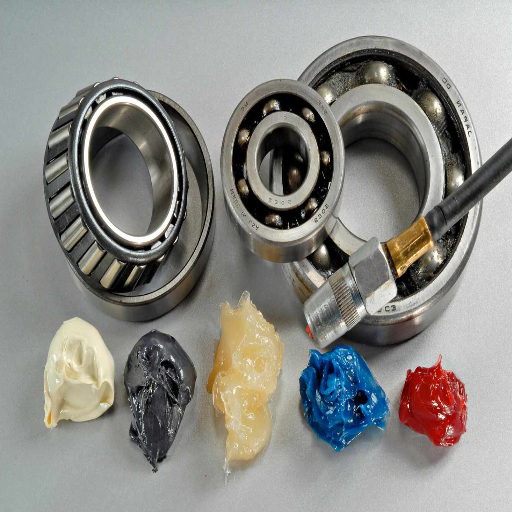
What factors should be considered when selecting a lubricant?
I first consider the temperature range because grease generally works better in fully sealed moderate to high-temperature applications, while oil is preferred in high-temperature extreme environments. After that, I will look at the load capacity. Typically, heavier loads require higher viscosity oils or heavy greases, making them thicker. Afterward, I consider the speed of the application as high-speed applications generally prefer low-viscosity oil, which is better for flow and cooling. And, as always, the environment in which the bearing or heavy machinery performs also has a significant impact – sealed grease is best for dusty environments or those with high contamination levels. In contrast, the submerged oil system performs best in clean and controlled conditions.
To just reinforce my choice, these are some of the technical parameters that I look for:
Load Bearing Capacity: Utilize strengthened grease or high-viscosity oil for thick film strength during heavy loads.
Speed Factor (DN Value): The discrepancy of the lubricant’s bearing speed and viscosity (low viscosity oil best suited for high-speed bearings).
Environmental Conditions: Depending on the risk of contamination, consider incorporating environmental forms, such as grease to seal or filtration system oils.
Maintenance Needs: Grease systems require less maintenance from an upkeep perspective; oil-based systems often actively employ filtration and circulation.
Matching each of these factors to the application’s requirements allows me to make a final choice between grease and oil, which fulfills both technical and operational needs.
Which type of lubricant is best for high-speed bearings?
When it comes to picking lubricants for high-speed bearings, I always reach for oil instead of grease as it has a higher tendency to withstand the impact of friction-induced heat generated by high-rate rotational speeds. Oil is also better in heat and friction, offering minimal resistance, which is crucial in high-speed settings.
Viscosity: Oils with low viscosity are suitable for high-speed rotational bearings because they reduce drag while retaining sufficient lubrication. Most sources cite a case-temperature viscosity of 10-15 cSt as the suitable range.
Thermal Management: The disadvantage of oils is that they are prone to overheating, which, if not managed, may lead to lubrication loss and bearing failure, which is the opposite in low-speed applications.
Shear Stability: Another drawback of grease is that it deteriorates almost instantly, while oil does not. Grease should only be used when smooth surfaces are present; otherwise, high shear will help maintain oil together for bearing surfaces.
Cleanliness: Air-free oils are filtered and cycled through oil lubrication systems covering many high-speed bearings, which would cause localized wear to bearings made from softer metals.
With revenge oil as my lubricant, allowing my bearings to romp freely while not starving them of longevity is my aim. As long as the parameters mentioned earlier are met, there shouldn’t be any issues in achieving that goal.
How does operating temperature affect the choice between grease and oil?
Choosing between grease and oil for lubrication depends significantly on the operating temperature. Oil is recommended for applications with higher temperatures due to its better thermal management properties and stability. However, depending on the base oil and thickener, heat may also deteriorate grease or cause it to lose its mechanical properties.
Viscosity Index: Oils with higher viscosity indices can perform better when mixing temperatures than those with lower viscosity.
Dropping Point (for grease): This means the temperature at which grease will start melting. I only use grease with a dropping point significantly higher than the operating temperatures to ensure the smooth running of the mechanism.
Thermal Conductivity (for oil): High thermal conductivity is significant for heat transfer.
Oxidation Stability: Grease and oil must withstand a high-temperature set point without deteriorating for extended periods, preventing the creation of sludge or other oxidation processes.
These operating temperature parameters are beneficial as they ensure consistent lubrication at various temperatures without compromising the equipment’s parts.
What are the benefits of using grease for bearing lubrication?
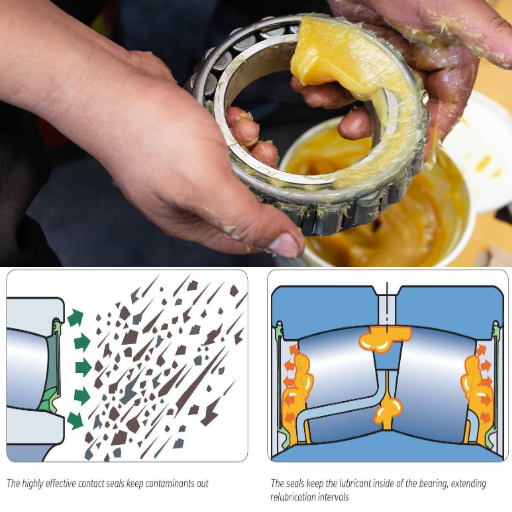
How does grease help with sealing and contaminant protection?
Grease can be considered a great sealing agent that locks it all together so that dirt, dust, or even moisture do not come in contact with the bearings. Due to its thickness, it acts as a blanket at the bearing interfaces, stopping contamination from penetrating and helping maintain the lubrication within the system. However, this can only be achieved if specific important technical parameters are considered:
Consistency (NLGI Grade): Grease texture or composition is essential to ensure the sealing surfaces work well. For instance, NLGI grades 1 to 3 grease enable satisfactory operation without leaks.
Water Washout Resistance (ASTM D1264): Water is not always beneficial in maintaining grease, as it can slowly erode its structure. Hence, low washout resistance enables good water protection while preventing structural damage to grease.
Mechanical Stability: Repeated mechanical force or pressure on grease for long durations doesn’t cause it to lose its composition. A well-structured composition ensures the grease’s sealing ability.
All the above factors enhance grease performance while reducing maintenance and repair time. Grease helps improve bearing life and the overall quality of machines, especially those working in harsh environments.
Why is grease preferred for vertical shaft applications?
Grease is considered better in the case of vertical shaft systems because of its physical properties which ensures having an adequate supply of lubricant and also the lubricant does not leak, such properties due to centrifugal forces and gravity helps in retaining the lubricant in the case of grease. Due to its liquid nature, oil tends to flow away, so it cannot be relied on for lubricating the moving parts for long; however, grease, on the other hand, has mechanical bonds and a strong affinity with surfaces. Some of the factors which are responsible for the above attributes are:
Viscosity and Tackiness: Adhesion and resistance to slipping caused by gravity are offered by high-viscosity base oils and tackifiers contained in grease.
Shear Stability: In vertical shafts, rotational modes exist, whereby turning forces are present. A grease with good shear stability can withstand these turning forces while maintaining its properties.
Dropping Point: Normal working environment for machinery comes with high temperature levels, having a high dropping point ensures that grease will not lose its physical and mechanical properties even when temperature is increased.
Thickener Type: For the best output in vertical applications, lithium complex, calcium sulfonate, or polyurea thickeners must be incorporated. These thickeners can withstand and provide strength against thermal and mechanical strain.
Retention Capability: In cases with vertical displacement and vibration, grease turns semi-solid and forms a film protecting the displacement of grease.
Overall, combining these characteristics will prevent wear and vertical contamination and ensure the reliable working and durability of the most violent shafts.
What role does grease consistency play in bearing performance?
The greases used in rotating or oscillating bearings have significant interplay, which depends on the consistency of the grease. The NLGI grade measures the viscosity of the grease and dictates the degree to which the grease will remain in place. An example of this type of grease is low-speed or centralized lubrication systems using NLGI grades 0 or 1, which can be utilized effectively. Other greases, such as NLGI grades 2 or 3, are more suited for applications with high temperature or rotary speed since those greases are more resistant to leakage and displacement when loaded.
NLGI Scale: The scale must operate under grease conditions (lower grades for more effortless flow and higher viscosity).
Operating Temperature Range: The various operating temperatures of the grease should not lead to a softening or hardening that exceeds the expected limits.
Shear Resistance: Involves understanding the weakening of the grease, for example, NLGI 2 to NLGI 1, after being subjected to stress for a prolonged time, which would negatively affect lubrication.
Dropping Point: Should withstand considerable heat during operation without liquefying.
The working hinges’ thickness of grease, which replaces air (grease, oil, etc.), minimizes energy loss, and improves the life of bearings in varying working conditions.
Can you mix grease and oil for bearing lubrication?
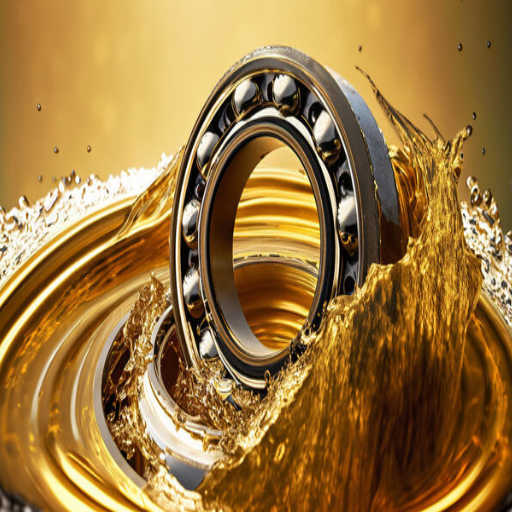
What are the potential risks of mixing grease and oil?
Using grease and oil in bearing lubrication presents several dangers that may affect the performance and longevity of the equipment. To begin with, there is also the risk that the thickener making up the grease may not mix well with the oil and, therefore, lose its ability to lubricate effectively—shrinkage of the film strength where the lubricant is possible, and more significant wear and friction results. On top of that, the end product may have a viscosity that is not in agreement with the stipulations of the particular engineering application, making it ineffective at the load and temperature levels.
Film Thickness: One of the most critical parameters is the viscosity of the application’s oil, which generally consists of csT as a standard measure at 40 and 100 degrees centigrade.
Type of Grease: Grease formulation, thickener, and the oil to be used must not have compatibility issues; an example of thickener are lithium complex and calcium sulphonate.
Temperature Limits: The application’s specific temperatures must be considered to prevent conflict with the mixture and thus prevent thermal damage.
Load Stress: The ability of the mixture’s lubrication film under swathe to pressure is critical under N/mm squared or PSI weight.
Under normal circumstances, avoiding blending grease and oil is prudent to prevent interference with lubrication performance unless the equipment manufacturers allow it or provide specific instructions regarding certain controlled experiments.
How can mixing affect lubricant performance and bearing life?
Blending grease with oil can have the following consequences on the performance of lubricants as well as the bearing life expectancy:
Change in Viscosity: Since the lubricant now has a blend, the viscosity is expected to shift from what was documented during testing. The side effect of such could be either insufficient lubrication or logging to flow, both of which would hasten wear. For instance, if the base oil does not have suitable cSt for a specific application, there is a probability that the lubrication film will be destroyed following pressure.
Loss in Thermal Efficiency: Lubricants typically have an ideal thermal efficiency, mixing with other sources degrades this thermal efficiency which hastens the oxidation and corrosion of grease and oil. Such occurrences might increase the operating temperature of the bearing, which may eventually succumb to damage.
Thickener Issues: Certain grease thickeners, such as lithium complex and polyurea, may not work harmoniously together, which destroys structure, separation of oil, and hardening of the grease. These events reduce lubrication, which brings the bearing to determine failure.
Additive Packages Trouble: Mixing lubricants with distinct additive packages would negatively impact their performance when combined, affecting the performance of anti-wear, anti-corrosion, and extreme pressure properties. Missing such critical elements risks shortening bearing life, especially for high loads exceeding 100 N/mm².
Contamination Risks: Blending might also bring in pollutants like dirt or water that break down the lubrication and add wear and tear. As the case may be, the bearing’s operational life may be significantly affected when water ingress exceeds the industrial standard of 0.1% by volume.
The manufacturer must specify lubricants for reliability and performance purposes. If mixing is unavoidable, an API testing procedure for viscosity, stability, and the mixture’s performance and additives will be performed.
How do maintenance requirements differ for grease and oil lubrication?
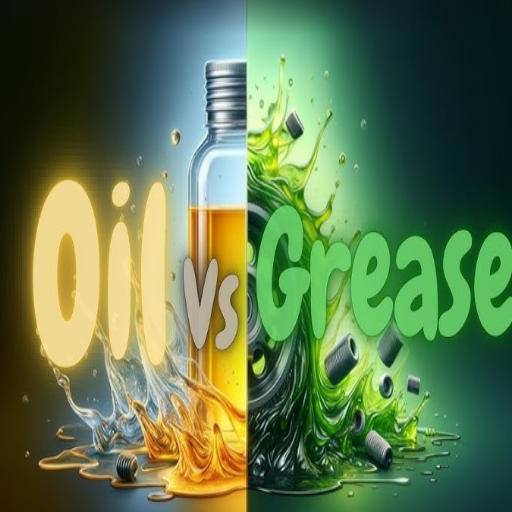
What are the typical relubrication intervals for grease vs. oil?
Specific operational principles, strain, temperature, and speed must be considered when estimating grease or oil relubrication periods.
Regarding grease lubrication, operational requirements suggest that re-lubrication should occur between weeks and a few months. When the temperature is around 60 degrees Celsius to 70 degrees Celsius, the grease has to be replaced every 2,000 to 4,000 operating hours. Still, if high temperatures exceeding 100 degrees Celsius are reached or speed and load are below average, the grease will need to be replaced promptly, every 500 – 1000.
Oil requires a greater degree of maintenance and care, mainly where no adequate circulatory and effective filtering system is in place. Oil in splash-lubed systems may require tweaking after every 500 – 2000 operating hours, whereas if it is a circulating oil system, the interval will be between 3000 – 7000 operating hours, depending on the filtration and cooling systems. However, an oil system should always be maintained and observed, as this would be the best way to establish best practices.
Optimizing the reliability and efficiency of specific specialized lubricants will require additional and controlled changes in the environment’s context and lubricant analyses or evaluations based on the structure’s nature and conditions.
How does lubricant monitoring differ between grease and oil systems?
Because of their distinct characteristics and use, the lubrication monitoring of grease and oil systems is entirely different.
Regarding grease systems, it is vital to routinely check the frequency of applying the grease and for contamination or hardening. The parameters that should be monitored include the grease consistency grade and temperature ASTM D217. For all defined parameters outlining greases’ performance, monitoring will ensure that these greases will always stick to surfaces, enabling them to provide adequate lubrication at varying loads and temperatures.
On the other hand, oil systems are more dependent on circulation and fluid oil, which is why they require more active monitoring. Critical parameters include viscosity, kinematic viscosity (cSt), oxidation, TAN, and water or particulate contamination. Regular sampling and analysis are necessary, especially for high-speed or high-temperature applications, to monitor changes in oil performance characteristics and degradation.
The main factor lies in the fact that the oil systems require more advanced monitoring tools, which sometimes require more frequent visits to the oil systems than to grease systems, which are less complicated and do not require as many advanced systems.
Frequently Asked Questions (FAQs)
Q: What are the main differences between oil and grease when lubricating the bearings?
A: Some major distinguishing points of oil and grease in bearing lubrication are their consistency, how they are applied, and how long they are retained. Oil is a liquefied lubricant with a completely free flow, while grease is an oil with a thickener added to produce a non-liquid substance. Oil is better for cooling and flushing out contaminants, while grease has a better time remaining in the bearing and better sealing characteristics.
Q: Under what conditions do I use grease or oil for bearing lubrication?
A: Grease is preferred for use on bearings running at low to medium speed when grease flow is inconvenient or when it is essential to seal grease from contaminants. Oil is preferred for high-speed bearings and equipment that require massive thermal transfer or continuous pressurization. Choosing between grease and oil will never be straightforward, as there are application temperatures, loads, and even surroundings to consider.
Q: Why would one prefer grease lubrication over oil lubrication in a bearing?
A: Grease is said to have several advantages over oil when used as a lubricant in bearings: It has better retention capabilities and thus does not need to be reapplied as often; it serves as a better seal against external pollution; it is more user-friendly; and it can service bearings regardless of their position. Grease is also less prone to leaking out of the bearing housing, making it more suitable in confined spaces.
Q: What consists of oil and grease in terms of their characteristics?
A: Oil consists of a base oil and certain specialized substances used to enhance and broaden the characteristics of an oil. Grease is approximately 70-95% base oil and 5-30% thickener, such as lithium, calcium, polyurea, and other substances. In grease, the thickener works like a sponge that absorbs the lubricant and only releases it onto the surface of the bearing where it is needed over some time. Grease has good boundary lubrication properties: it does not flow away quickly and lasts long.
Q: Out of oil and grease, what do you think performs better in high-speed bearings?
A: Oil is usually preferred for high-speed bearings. Oil flows better in high conditions, helps move dirt, and provides better cooling inside the bearing. Grease, being thick, causes more friction and heat in high-speed applications. However, some specially formulated greases can be used in high-speed applications, so it is best to check the manufacturer’s advice on which grease to use.
Q: How do oil and grease dissipate heat, and what is the difference?
A: Oil is better than grease for heat dissipation, as the heat oil flows all over the bearing. Grease has a relatively high viscosity and doesn’t circulate as much, so it doesn’t dissipate heat or oil. Lubrication with oil should work better for places where heat is the main issue, such as high-speed or heavily loaded bearings.
Q: Can I use oil instead of grease in a bearing designed for grease lubrication?
A: Oil can be used for a bearing designed to be lubricated with grease, but I feel it is incorrect somewhere. This is so because these bearings have oil bearing seals at 5 o’clock and 7 o’clock, which aren’t optimal, making them inefficient. Hence, the grease or lubrication oil diminishes well; consequently, the area is insufficiently lubricated, leading to damage or leakage of the bearings. Therefore, each individual must use them per the company’s instructions.
Q: How do synthetic oils and greases differ from their mineral-based ones?
A: Synthetic oils and greases are made using artificial base oils, unlike mineral oils and greases from petroleum oil. Although lubricants derived from minerals are helpful, synthetic lubricants are better in certain areas, such as withstand a more tremendous amount of temperatures without losing potency and a more fabulous shelf life. Also, they perform well in terms of viscosity characteristics, which can be helpful in lubricating bearings in difficult working conditions.
UCTH213-40J-300 with Setscrew(inch)
CNSORDERNO: Normal-duty(2)
TOGN: UCTH213-40J-300
SDI: B-R1/8
SD: 2 1/2
UCTH212-39J-300 with Setscrew(inch)
CNSORDERNO: Normal-duty(2)
TOGN: UCTH212-39J-300
SDI: B-R1/8
SD: 2 7/16
UCTH212-38J-300 with Setscrew(inch)
CNSORDERNO: Normal-duty(2)
TOGN: UCTH212-38J-300
SDI: B-R1/8
SD: 2 3/8
UCTH212-36J-300 with Setscrew(inch)
CNSORDERNO: Normal-duty(2)
TOGN: UCTH212-36J-300
SDI: B-R1/8
SD: 2 1/4
UCTH211-35J-300 with Setscrew(inch)
CNSORDERNO: Normal-duty(2)
TOGN: UCTH211-35J-300
SDI: B-R1/8
SD: 2 3/16
UCTH211-34J-300 with Setscrew(inch)
CNSORDERNO: Normal-duty(2)
TOGN: UCTH211-34J-300
SDI: B-R1/8
SD: 2 1/8









